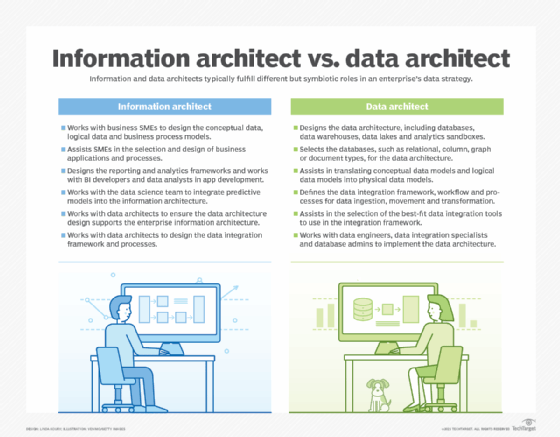Data architecture vs. information architecture: How they differ
Data architects collect the statistics and information architects put the numbers into context as they work symbiotically to bolster an enterprise's data and business strategies.
Many people believe data architecture and information architecture are one in the same. But this misconception has resulted in many poorly designed architectures that don't handle either data or information well.
The problem starts with confusion between data and information. They're related but different. Data is numbers, characters or other digital formats collected, updated and deleted in applications, business processes and devices. Information is data in context. Without context, a raw number is meaningless, but with it, that number could represent the sales amount of a takeout order, a temperature reading or a student's test score. Further context would reveal the who, what, when, where and how of that number, providing further information to analyze.
Data architecture vs. information architecture
An information architecture defines the context that an enterprise uses for its business operations and management. The building blocks of an information architecture are the organization's applications, business processes, and analytics and reporting systems -- plus its information workflow, internally and with customers, suppliers and business partners. Business requirements are used to develop the blueprint for the information architecture: conceptual data models, logical data models and business process models. Enterprise applications, whether built internally or purchased, need to use these models.
The data architecture provides a foundation for the information architecture by collecting, storing, moving, integrating and managing the required data. In a modern data architecture, data is ingested and stored in file systems and databases that span cloud, on-premises and hybrid environments. The basic building blocks of a data architecture are a data warehouse, staging data stores and business intelligence schemas. More sophisticated data architectures may add a data lake, analytics sandboxes, a data science hub and operational data stores.
A best-in-class data architecture implements data governance processes with supporting data quality and master data management initiatives. It also needs a data integration framework enabling a combination of integration capabilities -- traditional extract, transform and load (ETL) processes and the ELT variant often used in big data systems, plus data pipelines, data streaming, APIs, data preparation and application integration.
How are data architecture and information architecture related?
A modern data architecture needs an information architecture and vice versa.
An information architecture's blueprints include an enterprise data model, which, for example, defines an enterprise's customers and partners along with how it interacts with them in marketing, sales and support activities. The data architecture translates the data models into physical database designs and data elements used to capture, store and update the relevant data. An effective data architecture includes processes for transforming, curating, cleansing and governing data so that it becomes useful information.
A key shortcoming in many architectures is the oversimplification of how data is transformed into information. All too often, IT and data management teams think that data just needs to be moved or piped from source to target systems, failing to understand the need for different data contexts. Without data transformation based on data models and data definitions to implement the right contexts, analytics and reporting tools won't provide the correct insights. Even worse, the people using these tools may export the data into spreadsheets to try to create useful information. Doing so may provide the right context, but it's ineffective and unproductive.

What information architects do
Information architects must understand the business and what information it needs. They then ensure that applications, business processes and analytics and reporting systems can get that information.
An information architect's responsibilities include the following:
- Works with business subject matter experts (SMEs) to design the conceptual data models, logical data models and business process models that comprise the evolving enterprise data model.
- Assists SMEs in the selection and design of business applications and processes used to operate and manage the enterprise.
- Designs the reporting and analytics frameworks.
- Works with business intelligence developers and data analysts in the development of reporting and analytics applications.
- Works with the data science team to gather their requirements, support predictive modeling and machine learning development, and integrate the models and information they create into the information architecture.
- Works with data architects to ensure the data architecture design supports the enterprise information architecture.
- Works with data architects to design the data integration framework and processes.
What data architects do
Data architects design an enterprise's overall data architecture, including the data integration processes, business intelligence systems and supporting database and file systems. They gather business requirements based on an enterprise's long-term roadmap and current initiatives and examine areas where data issues are constraining operations, reducing productivity or inhibiting business growth.
Many data architects are now focused on cloud implementations or hybrid cloud deployments that combine cloud and on-premises systems. Multi-cloud architectures are also becoming more common.
A data architect's responsibilities include the following:
- Designs the data architecture, including databases, file systems, data warehouses, data lakes, analytics sandboxes and data science hubs.
- Selects the types of databases, such as relational, column, graph or document types, that are the best fit for the data architecture.
- Assists in translating conceptual and logical data models into physical data models.
- Defines the data integration framework, workflow and processes to enable data ingestion, movement and transformation.
- Assists in selecting the best-fit data integration tools to use in the integration framework.
- Works with data engineers, data integration specialists, database administrators and other members of the data management team to implement the data architecture.
Data strategy's effect on data and information architecture design
A data strategy is the vision for how data will enable an enterprise's business strategy and support its ongoing operations. Rather than viewing data as a byproduct of business activities, data is recognized as a corporate asset that needs to be planned for, defined and managed if the organization is to be successful. A data strategy includes a timeline, resource plans and financial justification to achieve its objectives. The information and data architectures are the blueprints for how an enterprise designs, builds and implements its data strategy and manages it.
An enterprise's data strategy, and therefore its information and data architectures, will evolve along with the evolution of the business, its competition and the market. In addition, technology changes will influence how these architectures are built and managed. The key to success is recognizing that change needs to be built into a data strategy and the data architecture and information architecture.
Symbiotic relationship
An enterprise needs an information architecture and a data architecture. The information architecture is informed by the organization's business strategy and operations. The data architecture supports the information architecture by providing the means to capture, transform, manage and govern the data needed to create useful information. The evolution of the two architectures provides an ongoing opportunity to increase the use of data and information and their business value.








